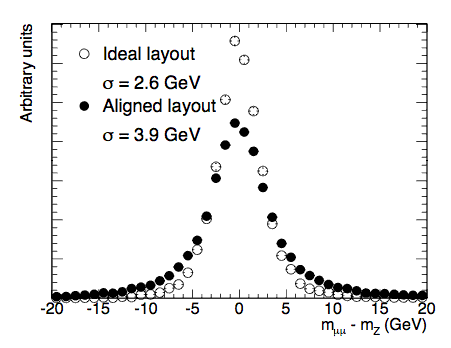
ATLAS e-News
23 February 2011
The alignment of the heart of the ATLAS detector is getting ready for operation phase
1 July 2008
 Inner Detector sensors and structural elements being traversed by two charged tracks
Inner Detector sensors and structural elements being traversed by two charged tracks
The ATLAS Inner Detector (ID) is instrumented with a charged particle tracking system based on two technologies: silicon (pixel and SCT) and straw drift tube (TRT) detectors. The performance of these detectors should be optimized in order to enable ATLAS to achieve its physics goals, such as high precision W-mass measurements (15-20 MeV/c2), efficient b-tagging and momentum resolution for leptons which is especially important for Higgs searches (H→ZZ→4l).
This means that the misalignment should not worsen the track parameter determination far beyond that of the intrinsic sensor resolution. The ID consists of a large number of modules (5832 silicon and 988 TRT modules) corresponding to an overwhelming 40944 degrees of freedom if a module is considered as a rigid body with 3 free translations and 3 free rotations around their local axes, excluding module deformations, such as bows and bends. Therefore, obtaining the desired precision urged the design and application of non-trivial alignment strategies and techniques in ID alignment hardware and software.
The ID alignment relies on track residual information. The current baseline algorithm uses a global simultaneous fit of all particle trajectories and alignment parameters. It considers several levels of alignment, i.e., for the silicon case, three different levels are performed. Level 1 alignment considers the whole Pixel detector, the SCT barrel and end-caps as four unique “super-modules” (rigid single structures) and the relative global alignment is determined. Level 2 considers different barrels and disks as super-modules for Pixel and SCT and Level 3 is the more granular method, which considers every single module. TRT currently considers two levels of alignment.

Difference between the reconstructed and true di-muon mass distribution for Z→µµ decays. The perfectly aligned detector results (open circles) are compared with the results from the first-pass alignment (full circles).
The daily work for the ID aligners has been very rich as we are always fighting on many fronts. The ID alignment algorithms were already put through real data-taking tests on several challenges as: Combined Test Beam, cosmic runs in SR1 and during Milestone, and the Computing System Commissioning (CSC) exercise which involved physics samples mimicking the ATLAS operation during data-taking which is just around the corner. The CSC alignment produced results for the ATLAS detector paper as shown on the figure above. In parallel, systematic deformations of the detector like those shown in the figure below have been considered and they are currently under study. The main aim is to have a deeper understanding of the weak modes (global deformations to which a track-based chi2method alignment has limited sensitivity) .
 Summary of possible systematic deformations
Summary of possible systematic deformations
The latest challenge was to participate in the 2nd Full Dress Rehearsal (FDR-2), where the daily operation readiness of offline data processing is exercised. One of the ID alignment groupís tasks is to set up the technical infrastructure to perform necessary steps of alignment chain in the 24 hour operations cycle. With the FDR exercises, we found ourselves starting to dance to the rhythm of the daily operations in data-taking. We used the FDR chance to design, implement, deliver, improve and automate the components of alignment processing.
In FDR-2, the ID alignment group needed to provide constants for two days of data. The aligners found themselves waking up to automatic SMS messages sent by the alignment processing at 03:00 am; this was really a FDR in anticipation of the data-taking phase for the ID! During this exercise, the ID calibration stream was used to test the algorithms with the final data format (one high pT track per event contrasting with the high track multiplicity events from simulations), as well as a small sample of cosmic ray data. The whole alignment processing was successfully done on the CERN Analysis Facility (CAF) using the dedicated nodes for alignment. Finally, this was the first time the Beam Spot Finder algorithm was integrated in the alignment chain. The whole process runs from a single mouse click.
For the alignment of the silicon tracker, a hardware alignment system based on Frequency Scanning Interferometry (FSI) is planned to be used in conjunction with the track-based algorithms. FSI is a system which measures the length of an array of grid lines in the SCT support structure and is designed to tackle the global deformations of the SCT.
The ID alignment groupís efforts have converged on a successfully working model, with pleasant and fruitful collaboration with our ID hardware and software colleagues. As we anxiously await for the LHC collisions, we are also looking into how to best exploit what the beam will provide us: such as using beam gas and halo events. Now that we have demonstrated we can deliver a baseline ID alignment, we are also expanding our horizons to understand the global alignment issues between other ATLAS subdetectors. As for the last words on ID alignment: they will come from the real LHC data, although definitely not on the very first day!

Muge Karagoz UnelOxford University, UK |

Carlos EscobarUniversity of Valencia, Spain
|